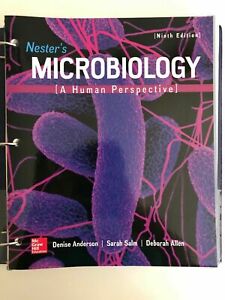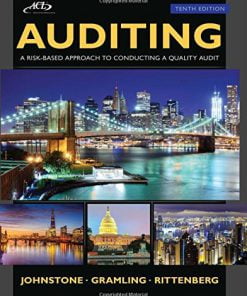Solution Manual for Nester’s Microbiology A Human Perspective 9th by Anderson
$35.00 Original price was: $35.00.$26.50Current price is: $26.50.
Solution Manual for Nester’s Microbiology A Human Perspective 9th by Anderson
This is completed downloadable of Solution Manual for Nester’s Microbiology A Human Perspective 9th by Anderson

Product Details:
- ISBN-10 : 125970999X
- ISBN-13 : 978-1259709999
- Author: Denise Anderson (Author), Sarah Salm (Author), Deborah Allen (Author)
Perfect for the non-major/allied health student (and also appropriate for mixed majors courses), this text provides a rock solid foundation in microbiology. By carefully and clearly explaining the fundamental concepts and offering vivid and appealing instructional art, Microbiology: A Human Perspective draws students back to their book again and again!
The text has a concise and readable style, covers the most current concepts, and gives students the knowledge and mastery necessary to understand advances of the future. A body systems approach is used in the coverage of diseases.
Table of Content:
- Part I Life and Death of Microorganisms
- 1 Humans and the Microbial World
- A Glimpse of History
- Key Terms
- 1.1 The Dispute over Spontaneous Generation
- Early Experiments
- Experiments of Pasteur
- Experiments of Tyndall
- The Golden Age of Microbiology
- The Scientific Method
- 1.2 Microbiology: A Human Perspective
- The Human Microbiome
- Microorganisms in the Environment
- Commercial Benefits of Microorganisms
- Microbes as Research Tools
- Microbes and Disease
- 1.3 Members of the Microbial World
- Scientific Names
- Bacteria
- Archaea
- Eukarya
- Acellular Infectious Agents
- Focus on a Case 1.1
- Focus Your Perspective 1.1: Every Rule Has an Exception
- Focus on the Future 1.1: Meet the Microbiomes!
- Summary
- Review Questions
- 2 The Molecules of Life
- A Glimpse of History
- Key Terms
- 2.1 Elements and Atoms
- Atomic Structure
- Isotopes
- The Role of Electrons
- 2.2 Chemical Bonds and Reactions
- Ions and Ionic Bonds
- Covalent Bonds
- Hydrogen Bonds
- Molarity
- Chemical Reactions
- 2.3 Water, pH, and Buffers
- Water
- pH of Aqueous Solutions
- Buffers
- 2.4 Organic Molecules
- Carbohydrates
- Lipids
- Proteins
- Nucleic Acids
- Focus on a Case 2.1
- Focus Your Perspective 2.1: Right-Handed and Left-Handed Molecules
- Summary
- Review Questions
- 3 Microscopy and Cell Structure
- A Glimpse of History
- Key Terms
- Microscopy and Cell Morphology
- 3.1 Microscopes
- Principles of Light Microscopy: Bright-Field Microscopes
- Light Microscopes That Increase Contrast
- Light Microscopes That Detect Fluorescence
- Electron Microscopes
- Scanning Probe Microscopes
- 3.2 Preparing Specimens for Light Microscopy
- Simple Staining
- Differential Staining
- Special Stains to Observe Cell Structures
- Fluorescent Dyes and Tags
- 3.3 Morphology of Prokaryotic Cells
- Shapes
- Arrangements
- Multicellular Associations
- Prokaryotic Cells
- 3.4 The Cytoplasmic Membrane of Prokaryotic Cells
- Structure of the Cytoplasmic Membrane
- Permeability of the Cytoplasmic Membrane
- The Role of the Cytoplasmic Membrane in Energy Transformation
- Transport of Small Molecules Across the Cytoplasmic Membrane
- Protein Secretion
- 3.5 The Cell Wall of Prokaryotic Cells
- Peptidoglycan
- The Gram-Positive Cell Wall
- The Gram-Negative Cell Wall
- Antibacterial Substances That Target Peptidoglycan
- Cell Wall Type and the Gram Stain
- Bacteria That Lack a Cell Wall
- Cell Walls of Archaea
- 3.6 Structures Outside the Cell Wall of Prokaryotic Cells
- Capsules and Slime Layers
- Flagella
- Pili
- 3.7 Internal Components of Prokaryotic Cells
- Chromosome and Plasmids
- Ribosomes
- Cytoskeleton
- Storage Granules
- Gas Vesicles
- Endospores
- Eukaryotic Cells
- 3.8 Cytoplasmic Membrane of Eukaryotic Cells
- Structure and Function of the Cytoplasmic Membrane
- Transfer of Molecules Across the Cytoplasmic Membrane
- 3.9 Protein Structures Within Eukaryotic Cells
- Ribosomes
- Cytoskeleton
- Flagella and Cilia
- 3.10 Membrane-Bound Organelles of Eukaryotic Cells
- Nucleus
- Mitochondria
- Chloroplasts
- Endoplasmic Reticulum (ER)
- Golgi Apparatus
- Lysosomes and Peroxisomes
- Focus on a Case 3.1
- Focus Your Perspective 3.1: Pathogens Hijacking Actin
- Summary
- Review Questions
- 4 Dynamics of Microbial Growth
- A Glimpse of History
- Key Terms
- 4.1 Principles of Microbial Growth
- 4.2 Microbial Growth in Nature
- Biofilms
- Interactions of Mixed Microbial Communities
- 4.3 Microbial Growth in Laboratory Conditions
- Obtaining a Pure Culture
- The Growth Curve
- Colony Growth
- Continuous Culture
- 4.4 Environmental Factors That Influence Microbial Growth
- Temperature Requirements
- Oxygen (O2) Requirements
- pH
- Water Availability
- 4.5 Nutritional Factors That Influence Microbial Growth
- Required Elements
- Growth Factors
- Energy Sources
- Nutritional Diversity
- 4.6 Cultivating Microorganisms in the Laboratory
- General Categories of Culture Media
- Special Types of Culture Media
- Providing Appropriate Atmospheric Conditions
- Enrichment Cultures
- 4.7 Methods to Detect and Measure Microbial Growth
- Direct Cell Counts
- Viable Cell Counts
- Measuring Biomass
- Detecting Cell Products
- Focus on a Case 4.1
- Focus Your Perspective 4.1: Can Microorganisms Live on Only Rocks and Water?
- Focus on the Future 4.1: Seeing How the Other 99% Lives
- Summary
- Review Questions
- 5 Control of Microbial Growth
- A Glimpse of History
- Key Terms
- 5.1 Approaches to Control
- Principles of Control
- Situational Considerations
- 5.2 Selecting an Antimicrobial Procedure
- Type of Microbes
- Number of Microorganisms
- Environmental Conditions
- Risk for Infection
- Composition of the Item
- 5.3 Using Heat to Destroy Microorganisms and Viruses
- Moist Heat
- Dry Heat
- 5.4 Using Other Physical Methods to Remove or Destroy Microbes
- Filtration
- Irradiation
- High Pressure
- 5.5 Using Chemicals to Destroy Microorganisms and Viruses
- Effectiveness of Germicidal Chemicals
- Selecting the Appropriate Germicidal Chemical
- Classes of Germicidal Chemicals
- 5.6 Preservation of Perishable Products
- Chemical Preservatives
- Low-Temperature Storage
- Reducing the Available Water
- Focus on a Case 5.1
- Focus on the Future 5.1: Too Much of a Good Thing?
- Summary
- Review Questions
- 6 Microbial Metabolism: Fueling Cell Growth
- A Glimpse of History
- Key Terms
- 6.1 Principles of Microbial Metabolism
- Energy
- Components of Metabolic Pathways
- Precursor Metabolites
- Overview of Catabolism
- 6.2 Enzymes
- Mechanisms and Consequences of Enzyme Action
- Cofactors
- Environmental Factors That Influence Enzyme Activity
- Allosteric Regulation
- Enzyme Inhibition
- 6.3 The Central Metabolic Pathways
- Glycolysis
- Pentose Phosphate Pathway
- Transition Step
- Tricarboxylic Acid (TCA) Cycle
- 6.4 Cellular Respiration
- The Electron Transport Chain (ETC)—Generating a Proton Motive Force
- ATP Synthase—Using the Proton Motive Force to Synthesize ATP
- ATP Yield of Aerobic Respiration in Prokaryotes
- 6.5 Fermentation
- 6.6 Catabolism of Organic Compounds Other Than Glucose
- Polysaccharides and Disaccharides
- Lipids
- Proteins
- 6.7 Chemolithotrophs
- 6.8 Photosynthesis
- Capturing Radiant Energy
- Converting Radiant Energy into Chemical Energy
- 6.9 Carbon Fixation
- Calvin Cycle
- 6.10 Anabolic Pathways—Synthesizing Subunits from Precursor Molecules
- Lipid Synthesis
- Amino Acid Synthesis
- Nucleotide Synthesis
- Focus on a Case 6.1
- Focus Your Perspective 6.1: Mining with Microbes
- Focus on the Future 6.1: Fueling the Future
- Summary
- Review Questions
- 7 The Blueprint of Life, from DNA to Protein
- A Glimpse of History
- Key Terms
- 7.1 Overview
- Characteristics of DNA
- Characteristics of RNA
- Regulating Gene Expression
- 7.2 DNA Replication
- Initiation of DNA Replication
- The Process of DNA Replication
- 7.3 Gene Expression in Bacteria
- Transcription
- Translation
- 7.4 Differences Between Eukaryotic and Prokaryotic Gene Expression
- 7.5 Sensing and Responding to Environmental Fluctuations
- Signal Transduction
- Natural Selection
- 7.6 Bacterial Gene Regulation
- Mechanisms to Control Transcription
- The lac Operon as a Model
- 7.7 Eukaryotic Gene Regulation
- 7.8 Genomics
- Analyzing a Prokaryotic DNA Sequence
- Metagenomics
- Focus on a Case 7.1
- Focus Your Perspective 7.1: RNA: The First Macromolecule?
- Focus on the Future 7.1: Gems in the Genomes?
- Summary
- Review Questions
- 8 Bacterial Genetics
- A Glimpse of History
- Key Terms
- 8.1 Genetic Change in Bacteria
- Mutation as a Mechanism of Genetic Change
- 8.2 Spontaneous Mutations
- Base Substitution
- Deletion or Addition of Nucleotides
- Transposons (Jumping Genes)
- 8.3 Induced Mutations
- Chemical Mutagens
- Transposition
- Radiation
- 8.4 Repair of Damaged DNA
- Repair of Errors in Nucleotide Incorporation
- Repair of Modified Nucleobases in DNA
- Repair of Thymine Dimers
- SOS Repair
- 8.5 Mutant Selection
- Direct Selection
- Indirect Selection
- Screening for Possible Carcinogens
- Horizontal Gene Transfer as a Mechanism of Genetic Change
- 8.6 DNA-Mediated Transformation
- Competence
- The Process of Transformation
- 8.7 Transduction
- 8.8 Conjugation
- Plasmid Transfer
- Chromosome Transfer
- F′ Donors
- 8.9 The Mobile Gene Pool
- Plasmids
- Transposons
- Genomic Islands
- Phage DNA
- 8.10 Bacterial Defenses Against Invading DNA
- Restriction-Modification Systems
- CRISPR Systems
- Focus on a Case 8.1
- Focus Your Perspective 8.1: The Biological Function of DNA: A Discovery Ahead of Its Time
- Focus Your Perspective 8.2: Bacteria Can Conjugate with Plants: A Natural Case of Genetic Engineering
- Summary
- Review Questions
- 9 Biotechnology
- A Glimpse of History
- Key Terms
- 9.1 Fundamental Tools Used in Biotechnology
- Restriction Enzymes
- DNA Gel Electrophoresis
- CRISPR/Cas9
- 9.2 Genetic Engineering
- Genetically Engineered Bacteria
- Genetically Engineered Eukaryotes
- Techniques Used to Clone DNA
- Concerns Regarding Genetic Engineering
- 9.3 DNA Sequencing
- DNA Sequencing Methods
- 9.4 Polymerase Chain Reaction (PCR)
- Variations of Conventional PCR
- PCR Methods
- 9.5 Probe Technologies
- Colony Blotting
- Fluorescence In Situ Hybridization (FISH)
- DNA Microarrays
- Focus on a Case 9.1
- Focus on the Future 9.1: Precision Medicine
- Summary
- Review Questions
- Part II The Microbial World
- 10 Identifying and Classifying Microorganisms
- A Glimpse of History
- Key Terms
- 10.1 Principles of Taxonomy
- Strategies Used to Identify Microorganisms
- Strategies Used to Classify Microorganisms
- Nomenclature
- 10.2 Identification Methods Based on Phenotype
- Microscopic Morphology
- Culture Characteristics
- Metabolic Capabilities
- Serological Testing
- Protein Profile
- 10.3 Identification Methods Based on Genotype
- Detecting Specific Nucleotide Sequences
- Sequencing Ribosomal RNA Genes
- 10.4 Characterizing Strain Differences
- Biochemical Typing
- Serological Typing
- Molecular Typing
- Phage Typing
- Antibiograms
- 10.5 Classifying Microorganisms
- Sequence Analysis of Ribosomal Components
- DNA Hybridization
- G + C Content
- Phenotypic Methods
- Focus on a Case 10.1
- Focus on the Future 10.1: Pushing the Limits of MALDI-TOF MS
- Summary
- Review Questions
- 11 The Diversity of Bacteria and Archaea
- A Glimpse of History
- Key Terms
- Metabolic Diversity
- 11.1 Anaerobic Chemotrophs
- Anaerobic Chemolithotrophs
- Anaerobic Chemoorganotrophs—Anaerobic Respiration
- Anaerobic Chemoorganotrophs—Fermentation
- 11.2 Anoxygenic Phototrophs
- Purple Bacteria
- Green Bacteria
- Other Anoxygenic Phototrophs
- 11.3 Oxygenic Phototrophs
- Cyanobacteria
- 11.4 Aerobic Chemolithotrophs
- Sulfur-Oxidizing Bacteria
- Nitrifiers
- Hydrogen-Oxidizing Bacteria
- 11.5 Aerobic Chemoorganotrophs
- Obligate Aerobes
- Facultative Anaerobes
- Ecophysiological Diversity
- 11.6 Thriving in Terrestrial Environments
- Bacteria That Form a Resting Stage
- Bacteria That Associate with Plants
- 11.7 Thriving in Aquatic Environments
- Sheathed Bacteria
- Prosthecate Bacteria
- Bacteria That Derive Nutrients from Other Organisms
- Bacteria That Move by Unusual Mechanisms
- Bacteria That Form Storage Granules
- 11.8 Animals as Habitats
- Bacteria That Inhabit the Skin
- Bacteria That Inhabit Mucous Membranes
- Obligate Intracellular Parasites
- 11.9 Archaea That Thrive in Extreme Conditions
- Extreme Halophiles
- Extreme Thermophiles
- Focus on a Case 11.1
- Focus on the Future 11.1: Astrobiology: Searching for Life Beyond Earth
- Summary
- Review Questions
- 12 The Eukaryotic Members of the Microbial World
- A Glimpse of History
- Key Terms
- 12.1 Fungi
- Types of Fungi
- Structure of Fungi
- Fungal Habitats
- Symbiotic Relationships of Fungi
- Reproduction in Fungi
- Economic Importance of Fungi
- Medical Importance of Fungi
- 12.2 Algae
- Types of Algae
- Structure of Algae
- Algal Habitats
- Algal Reproduction
- Medical Importance of Algae
- 12.3 Protozoa
- Types of Protozoa
- Structure of Protozoa
- Protozoan Habitats
- Protozoan Reproduction
- Medical Importance of Protozoa
- 12.4 Slime Molds and Water Molds
- Slime Molds
- Water Molds
- 12.5 Multicellular Parasites: Helminths
- Life Cycles and Transmission of Helminths
- Roundworms (Nematodes)
- Tapeworms (Cestodes)
- Flukes (Trematodes)
- 12.6 Arthropods
- Focus on a Case 12.1
- Focus Your Perspective 12.1: What Causes River Blindness?
- Summary
- Review Questions
- 13 Viruses, Viroids, and Prions
- A Glimpse of History
- Key Terms
- 13.1 General Characteristics of Viruses
- Viral Architecture
- Viral Taxonomy
- 13.2 Bacteriophages
- Lytic Phage Infections: T4 Phage as a Model
- Temperate Phage Infections: Lambda Phage as a Model
- Filamentous Phage Infections: M13 Phage as a Model
- 13.3 The Roles of Bacteriophages in Horizontal Gene Transfer
- Generalized Transduction
- Specialized Transduction
- 13.4 Methods Used to Study Bacteriophages
- 13.5 Animal Virus Replication
- Attachment
- Penetration and Uncoating
- Synthesis of Viral Proteins and Replication of the Genome
- Assembly and Maturation
- Release
- 13.6 Categories of Animal Virus Infections
- Acute Infections
- Persistent Infections
- 13.7 Viruses and Human Tumors
- 13.8 Cultivating and Quantitating Animal Viruses
- Cultivating Animal Viruses
- Quantitating Animal Viruses
- 13.9 Plant Viruses
- 13.10 Other Infectious Agents: Viroids and Prions
- Viroids
- Prions
- Focus on a Case 13.1
- Focus Your Perspective 13.1: Microbe Mimicker
- Summary
- Review Questions
- Part III Microorganisms and Humans
- 14 The Innate Immune Response
- A Glimpse of History
- Key Terms
- 14.1 Overview of the Innate Immune Defenses
- 14.2 First-Line Defenses
- Physical Barriers
- Antimicrobial Substances
- Normal Microbiota (Flora)
- 14.3 The Cells of the Immune System
- Granulocytes
- Mononuclear Phagocytes
- Dendritic Cells
- Lymphocytes
- 14.4 Cell Communication
- Surface Receptors
- Cytokines
- Adhesion Molecules
- 14.5 Pattern Recognition Receptors (PRRs)
- Pattern Recognition Receptors (PRRs) that Monitor a Cell’s Surroundings
- Pattern Recognition Receptors (PRRs) That Monitor Material Ingested by a Cell
- Pattern Recognition Receptors (PRRs) That Monitor a Cell’s Cytoplasm
- An Outcome of Cytoplasmic Pattern Recognition: The Interferon Response
- 14.6 The Complement System
- Complement System Activation
- Effector Functions of the Complement System
- Regulation of the Complement System
- 14.7 Phagocytosis
- The Process of Phagocytosis
- Characteristics of Macrophages
- Characteristics of Neutrophils
- 14.8 The Inflammatory Response
- Factors That Trigger an Inflammatory Response
- The Inflammatory Process
- Damaging Effects of Inflammation
- Cell Death and the Inflammatory Response
- 14.9 Fever
- Focus on a Case 14.1
- Focus Your Perspective 14.1: For Schistosoma, the Inflammatory Response Delivers
- Summary
- Review Questions
- 15 The Adaptive Immune Response
- A Glimpse of History
- Key Terms
- 15.1 Overview of the Adaptive Immune Response
- Humoral Immunity
- Cell-Mediated Immunity
- 15.2 Anatomy of the Lymphatic System
- Lymphatic Vessels
- Secondary Lymphoid Organs
- Primary Lymphoid Organs
- 15.3 The Nature of Antigens
- 15.4 The Nature of Antibodies
- Structure and Properties of Antibodies
- Protective Outcomes of Antibody-Antigen Binding
- Immunoglobulin Classes
- 15.5 Clonal Selection and Expansion of Lymphocytes
- 15.6 The B-Cell Response: Humoral Immunity
- B-Cell Activation
- Characteristics of the Primary Response
- Characteristics of the Secondary Response
- The Response to T-Independent Antigens
- 15.7 The T-Cell Response: Cell-Mediated Immunity
- General Characteristics of T Cells
- Activation of T Cells
- Effector Functions of TC (CD8) Cells
- Effector Functions of TH (CD4) Cells
- 15.8 Natural Killer (NK) Cells
- 15.9 Lymphocyte Development
- Generation of Diversity
- Negative Selection of Self-Reactive B Cells
- Positive and Negative Selection of Self-Reactive T Cells
- Focus on a Case 15.1
- Focus Your Perspective 15.1: What Flavors Are Your Major Histocompatibility Complex Molecules?
- Summary
- Review Questions
- 16 Host-Microbe Interactions
- A Glimpse of History
- Key Terms
- Microbes, Health, and Disease
- 16.1 The Anatomical Barriers as Ecosystems
- 16.2 The Human Microbiome
- Composition of the Microbiome
- Beneficial Roles of the Human Microbiome
- 16.3 Principles of Infectious Disease
- Pathogenicity
- Characteristics of Infectious Disease
- 16.4 Determining the Cause of an Infectious Disease
- Koch’s Postulates
- Molecular Koch’s Postulates
- Mechanisms of Pathogenesis
- 16.5 Establishing Infection
- Adherence
- Colonization
- Delivering Effector Proteins to Host Cells
- 16.6 Invasion—Breaching the Anatomical Barriers
- Penetrating the Skin
- Penetrating Mucous Membranes
- 16.7 Avoiding the Host Defenses
- Hiding Within a Host Cell
- Avoiding Destruction by Phagocytes
- Avoiding Killing by Complement System Proteins
- Avoiding Recognition by Antibodies
- 16.8 Damage to the Host
- Exotoxins
- Endotoxin and Other Bacterial Cell Wall Components
- Damaging Effects of the Immune Response
- 16.9 Mechanisms of Viral Pathogenesis
- Binding to Host Cells and Invasion
- Avoiding Immune Responses
- Damage to the Host
- 16.10 Mechanisms of Eukaryotic Pathogenesis
- Fungi
- Protozoa and Helminths
- Focus on a Case 16.1
- Focus on the Future 16.1: The Potential of Probiotics
- Summary
- Review Questions
- 17 Immunological Disorders
- A Glimpse of History
- Key Terms
- 17.1 Hypersensitivities
- Type I Hypersensitivities: Immediate IgE-Mediated
- Type II Hypersensitivities: Cytotoxic
- Type III Hypersensitivities: Immune Complex–Mediated
- Type IV Hypersensitivities: Delayed-Type Cell-Mediated
- 17.2 Autoimmune Disease
- The Range of Autoimmune Diseases
- Treatment of Autoimmune Diseases
- 17.3 Immunodeficiency Disorders
- Primary Immunodeficiencies
- Secondary Immunodeficiencies
- Focus on a Case 17.1
- Focus Your Perspective 17.1: The Fetus as an Allograft
- Summary
- Review Questions
- 18 Applications of Immune Responses
- A Glimpse of History
- Key Terms
- Immunization
- 18.1 Principles of Immunization
- Active Immunity
- Passive Immunity
- 18.2 Vaccines and Immunization Procedures
- Attenuated Vaccines
- Inactivated Vaccines
- The Importance of Vaccines
- An Example of Vaccination Strategy—The Campaign to Eliminate Poliomyelitis
- Immunological Testing
- 18.3 Principles of Immunoassays
- Quantifying Antigen-Antibody Reactions
- Obtaining Known Antibodies
- 18.4 Common Types of Immunoassays
- Immunoassays That Use Labeled Antibodies
- Immunoassays That Involve Visible Antigen-Antibody Aggregates
- Focus on a Case 18.1
- Focus Your Perspective 18.1:
- Focus on the Future 18.1: Conquering Cancer
- Summary
- Review Questions
- 19 Epidemiology
- A Glimpse of History
- Key Terms
- 19.1 Basic Concepts of Epidemiology
- 19.2 Chain of Infection
- Reservoirs of Infection
- Portals of Exit
- Disease Transmission
- Portals of Entry
- 19.3 Factors That Influence the Epidemiology of Disease
- Characteristics of the Pathogen
- Characteristics of the Host
- Characteristics of the Environment
- 19.4 Epidemiological Studies
- Descriptive Studies
- Analytical Studies
- Experimental Studies
- 19.5 Infectious Disease Surveillance
- National Disease Surveillance Network
- Worldwide Disease Surveillance
- Reduction and Eradication of Disease
- 19.6 Emerging Infectious Diseases
- 19.7 Healthcare-Associated Infections
- Reservoirs of Infectious Agents in Healthcare Settings
- Transmission of Infectious Agents in Healthcare Settings
- Preventing Healthcare-Associated Infections
- Focus on a Case 19.1
- Focus Your Perspective 19.1: Standard Precautions—Protecting Patients and Healthcare Personnel
- Focus on the Future 19.1: Maintaining Vigilance Against Bioterrorism
- Summary
- Review Questions
- 20 Antimicrobial Medications
- A Glimpse of History
- Key Terms
- 20.1 History and Development of Antimicrobial Medications
- Discovery of Antimicrobial Medications
- Discovery of Antibiotics
- Development of New Antimicrobial Medications
- 20.2 Characteristics of Antimicrobial Medications
- Selective Toxicity
- Antimicrobial Action
- Spectrum of Activity
- Effects of Antimicrobial Combinations
- Tissue Distribution, Metabolism, and Excretion of the Medication
- Adverse Effects
- Resistance to Antimicrobials
- 20.3 Mechanisms of Action of Antibacterial Medications
- Inhibit Cell Wall Synthesis
- Inhibit Protein Synthesis
- Inhibit Nucleic Acid Synthesis
- Interfere with Metabolic Pathways
- Interfere with Cell Membrane Integrity
- Effective Against Mycobacterium tuberculosis
- 20.4 Antimicrobial Susceptibility Testing
- Conventional Disc Diffusion Method
- Minimum Inhibitory and Minimum Bactericidal Concentrations (MIC and MBC)
- Commercial Modifications of Antimicrobial Susceptibility Testing
- 20.5 Resistance to Antimicrobial Medications
- Mechanisms of Acquired Resistance
- Acquisition of Resistance
- Examples of Emerging Resistance
- Preventing Resistance
- 20.6 Mechanisms of Action of Antiviral Medications
- Prevent Viral Entry
- Interfere with Viral Uncoating
- Interfere with Nucleic Acid Synthesis
- Prevent Genome Integration
- Prevent Assembly and Release of Viral Particles
- 20.7 Mechanisms of Action of Antifungal Medications
- Interfere with Cytoplasmic Membrane Synthesis and Function
- Interfere with Cell Wall Synthesis
- Interfere with Cell Division
- Interfere with Nucleic Acid Synthesis
- Interfere with Protein Synthesis
- 20.8 Mechanisms of Action of Antiprotozoan and Antihelminthic Medications
- Focus on a Case 20.1
- Focus Your Perspective 20.1:
- Focus on the Future 20.1: Combating Antibiotic Resistance
- Summary
- Review Questions
- Part IV Infectious Diseases
- 21 Respiratory System Infections
- A Glimpse of History
- Key Terms
- 21.1 Anatomy, Physiology, and Ecology of the Respiratory System
- The Upper Respiratory Tract
- The Lower Respiratory Tract
- Upper Respiratory Tract Infections
- 21.2 Bacterial Infections of the Upper Respiratory System
- Pink Eye, Earache, and Sinus Infections
- Streptococcal Pharyngitis (“Strep Throat”)
- Post-Streptococcal Sequelae
- Diphtheria
- 21.3 Viral Infections of the Upper Respiratory System
- The Common Cold
- Adenovirus Respiratory Tract Infections
- Lower Respiratory Tract Infections
- Focus on Pneumonia
- 21.4 Bacterial Infections of the Lower Respiratory System
- Pneumococcal Pneumonia
- Klebsiella Pneumonia
- Mycoplasmal Pneumonia (“Walking Pneumonia”)
- Pertussis (“Whooping Cough”)
- Tuberculosis (“TB”)
- Legionellosis (“Legionnaires’ Disease”)
- Inhalation Anthrax
- 21.5 Viral Infections of the Lower Respiratory System
- Influenza (“Flu”)
- Respiratory Syncytial Virus (RSV) Infections
- Hantavirus Pulmonary Syndrome
- SARS and MERS
- 21.6 Fungal Infections of the Lung
- Coccidioidomycosis (“Valley Fever”)
- Histoplasmosis (“Spelunker’s Disease”)
- Pneumocystis Pneumonia (PCP)
- Focus on a Case 21.1
- Summary
- Review Questions
- 22 Skin Infections
- A Glimpse of History
- Key Terms
- 22.1 Anatomy, Physiology, and Ecology of the Skin
- 22.2 Bacterial Diseases of the Skin
- Acne Vulgaris
- Hair Follicle Infections
- Staphylococcal Scalded Skin Syndrome
- Impetigo
- Rocky Mountain Spotted Fever
- Cutaneous Anthrax
- 22.3 Viral Diseases of the Skin
- Varicella (Chickenpox)
- Rubeola (Measles)
- Rubella (German Measles)
- Other Viral Rashes of Childhood
- Warts
- 22.4 Fungal Diseases of the Skin
- Superficial Cutaneous Mycoses
- Other Fungal Diseases
- Focus on a Case 22.1
- Focus Your Perspective 22.1: The Ghost of Smallpox: An Evil Shade
- Summary
- Review Questions
- 23 Wound Infections
- A Glimpse of History
- Key Terms
- 23.1 Anatomy, Physiology, and Ecology of Wounds
- Wound Abscesses
- Anaerobic Wounds
- 23.2 Common Bacterial Infections of Wounds
- Staphylococcal Wound Infections
- Group A Streptococcal “Flesh-Eating Disease”
- Pseudomonas aeruginosa Infections
- 23.3 Diseases Due to Anaerobic Bacterial Wound Infections
- Tetanus (“Lockjaw”)
- Clostridial Myonecrosis (“Gas Gangrene”)
- 23.4 Bacterial Infections of Bite Wounds
- Human Bites
- Pasteurella multocida Bite Wound Infections
- Bartonellosis (“Cat Scratch Disease”)
- Streptobacillary Rat Bite Fever
- 23.5 Fungal Wound Infections
- Sporotrichosis (“Rose Gardener’s Disease”)
- Focus on a Case 23.1
- Focus Your Perspective 23.1: Infection Caused by a Human “Bite”
- Summary
- Review Questions
- 24 Digestive System Infections
- A Glimpse of History
- Key Terms
- 24.1 Anatomy, Physiology, and Ecology of the Digestive System
- The Upper Digestive System
- The Lower Digestive System
- Upper Digestive System Infections
- 24.2 Bacterial Diseases of the Upper Digestive System
- Dental Caries (Tooth Decay)
- Periodontal Disease
- Acute Necrotizing Ulcerative Gingivitis
- Helicobacter pylori Gastritis
- 24.3 Viral Diseases of the Upper Digestive System
- Oral Herpes Simplex (Cold Sores)
- Mumps
- Lower Digestive System Infections
- Focus on Diarrheal Diseases
- 24.4 Bacterial Diseases of the Lower Digestive System
- Cholera
- Shigellosis
- Escherichia coli Gastroenteritis
- Salmonella Gastroenteritis
- Typhoid and Paratyphoid Fevers
- Campylobacteriosis
- Clostridium difficile Infection (CDI)
- 24.5 Viral Diseases of the Lower Digestive System— Intestinal Tract
- Rotavirus Gastroenteritis
- Norovirus Gastroenteritis
- 24.6 Viral Diseases of the Lower Digestive System— Liver
- Hepatitis A
- Hepatitis B
- Hepatitis C
- 24.7 Protozoan Diseases of the Lower Digestive System
- Giardiasis
- Cryptosporidiosis (“Crypto”)
- Cyclosporiasis
- Amebiasis
- Focus on a Case 24.1
- Summary
- Review Questions
- 25 Blood and Lymphatic Infections
- 25.1 Anatomy, Physiology, and Ecology of the Blood and Lymphatic Systems
- The Heart
- Blood Vessels
- Lymphatics (Lymphatic Vessels)
- Spleen
- 25.2 Bacterial Diseases of the Blood and Lymphatic Systems
- Infective Endocarditis
- Sepsis and Septic Shock
- Plague (“Black Death”)
- Lyme Disease
- Vibrio vulnificus Infection
- Tularemia (“Rabbit Fever” or “Deer Fly Fever”)
- Brucellosis (“Undulant Fever” or “Bang’s Disease”)
- 25.3 Viral Diseases of the Blood and Lymphatic Systems
- Infectious Mononucleosis (“Mono” or “Kissing Disease”)
- Ebola Virus Disease (EVD) and Marburg Virus Disease (MVD)
- Yellow Fever
- Dengue Fever
- Chikungunya
- Zika Virus Disease
- 25.4 Protozoan Diseases of the Blood and Lymphatic Systems
- Malaria
- Focus on a Case 25.1
- Summary
- Review Questions
- 26 Nervous System Infections
- A Glimpse of History
- Key Terms
- 26.1 Anatomy, Physiology, and Ecology of the Nervous System
- Central Nervous System Infections
- Focus on Meningitis
- 26.2 Bacterial Diseases of the Central Nervous System
- Pneumococcal Meningitis
- Meningococcal Meningitis
- Haemophilus influenzae Meningitis
- Neonatal Meningitis
- Listeriosis
- 26.3 Viral Diseases of the Central Nervous System
- Viral Meningitis
- Viral Encephalitis
- Poliomyelitis
- Rabies
- 26.4 Fungal Diseases of the Central Nervous System
- Cryptococcal Meningoencephalitis
- 26.5 Protozoan Diseases of the Central Nervous System
- African Trypanosomiasis (“African Sleeping Sickness”)
- Toxoplasmosis
- Primary Amebic Meningoencephalitis (PAM)
- 26.6 Diseases Caused by Prions
- Transmissible Spongiform Encephalopathies in Humans
- Peripheral Nervous System Infections
- 26.7 Bacterial Diseases of the Peripheral Nervous System
- Hansen’s Disease (Leprosy)
- Botulism
- Focus on a Case 26.1
- Focus Your Perspective 26.1: Rabies Survivors!
- Summary
- Review Questions
- 27 Genitourinary Tract Infections
- A Glimpse of History
- Key Terms
- 27.1 Anatomy, Physiology, and Ecology of the Genitourinary System
- The Urinary System
- The Genital System
- 27.2 Urinary Tract Infections
- Bacterial Cystitis (“Bladder Infection”)
- Leptospirosis
- 27.3 Genital System Diseases
- Bacterial Vaginosis (BV)
- Vulvovaginal Candidiasis (VVC)
- Staphylococcal Toxic Shock Syndrome
- Sexually Transmitted Infections
- Focus on Sexually Transmitted Infections
- 27.4 Bacterial STIs
- Chlamydial Infections
- Gonorrhea
- Mycoplasma genitalium Infections
- Syphilis
- Chancroid
- 27.5 Viral STIs
- Genital Herpes
- Human Papillomavirus STIs: Genital Warts and Cervical Cancer
- HIV/AIDS
- 27.6 Protozoan STIs
- Trichomoniasis (“Trich”)
- Focus on a Case 27.1
- Focus Your Perspective 27.1: The Death of Syphilis?
- Focus on the Future 27.1: Getting Control of Sexually Transmitted Infections
- Summary
- Review Questions
- Part V Applied Microbiology
- 28 Microbial Ecology
- A Glimpse of History
- Key Terms
- 28.1 Principles of Microbial Ecology
- Nutrient Acquisition
- Microbes in Low-Nutrient Environments
- Microbial Competition
- Microorganisms and Environmental Changes
- Microbial Communities
- 28.2 Studying Microbial Ecology
- 28.3 Aquatic Habitats
- Marine Environments
- Freshwater Environments
- Specialized Aquatic Environments
- 28.4 Terrestrial Habitats
- Characteristics of Soil
- Microorganisms in Soil
- 28.5 Biogeochemical Cycling and Energy Flow
- Carbon Cycle
- Nitrogen Cycle
- Sulfur Cycle
- Phosphorus Cycle and Other Cycles
- Energy Sources for Ecosystems
- 28.6 Mutualistic Relationships Between Microorganisms and Eukaryotes
- Mycorrhizas
- Symbiotic Nitrogen-Fixers and Plants
- Microorganisms and Herbivores
- Focus on a Case 28.1
- Summary
- Review Questions
- 29 Environmental Microbiology: Treatment of Water, Wastes, and Polluted Habitats
- A Glimpse of History
- Key Terms
- 29.1 Microbiology of Wastewater Treatment
- Biochemical Oxygen Demand (BOD)
- Municipal Wastewater Treatment Methods
- Individual Wastewater Treatment Systems
- 29.2 Drinking Water Treatment and Testing
- Water Treatment Processes
- Water Testing
- 29.3 Microbiology of Solid Waste Treatment
- Sanitary Landfills for Solid Waste Disposal
- Municipal and Backyard Composting—Alternative to Landfills
- 29.4 Microbiology of Bioremediation
- Pollutants
- Strategies of Bioremediation
- Focus on a Case 29.1
- Summary
- Review Questions
- 30 Food Microbiology
- A Glimpse of History
- Key Terms
- 30.1 Factors Influencing the Growth of Microorganisms in Foods
- Intrinsic Factors
- Extrinsic Factors
- 30.2 Microorganisms in Food and Beverage Production
- Lactic Acid Fermentations by the Lactic Acid Bacteria
- Alcoholic Fermentations by Yeast
- Changes Due to Mold Growth
- 30.3 Food Spoilage
- Common Spoilage Bacteria
- Common Spoilage Fungi
- 30.4 Foodborne Illness
- Foodborne Intoxication
- Foodborne Infection
- 30.5 Food Preservation
- Focus on a Case 30.1
- Focus Your Perspective 30.1: Botox for Beauty and Pain Relief
- Summary
- Review Questions
- Appendix I Microbial Mathematics
- Appendix II Pronunciation Key for Bacterial, Fungal, Protozoan, and Viral Names
- Appendix III Metabolic Pathways
- Appendix IV Answers to Multiple Choice Questions
- Appendix V Microbial Terminology
- Glossary/Index
People Also Search:
nester’s microbiology a human perspective
nester’s microbiology a human perspective 9th edition
nester’s microbiology a human perspective 9th by anderson
nester’s microbiology a human perspective 9th solution manual download pdf
nester’s microbiology a human perspective 9th download scribd
Related products
Solution Manual
Understanding Business Nickels 10th Edition Solutions Manual
Solution Manual
Solution manual for Accounting: Tools for Business Decision Making Kimmel Weygandt Kieso 5th Edition
Solution Manual
Prentice Hall’s Federal Taxation 2014 Comprehensive Rupert 27th Edition Solutions Manual
Solution Manual
Auditing A Risk Based-Approach to Conducting a Quality Audit Johnstone 10th Edition Solutions Manual
Solution Manual
Solution Manual
Solution Manual
Management Information Systems Managing the Digital Firm Laudon 14th Edition Solutions Manual











